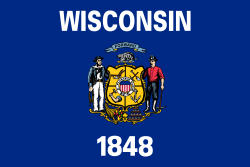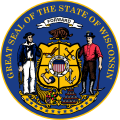Wisconsin
Wisconsin is a state in the Upper Midwest region of the United States. The capital of Wisconsin is Madison. The biggest city in Wisconsin is Milwaukee.
| State of Wisconsin | |
|
| |
|
| |
| Anthem: On, Wisconsin! | |
 Map of the United States with Wisconsin highlighted | |
| Country | United States |
| Before statehood | Wisconsin Territory |
| Admitted to the Union | May 29, 1848 (30th) |
| Capital | Madison |
| Largest city | Milwaukee |
| Largest metro | Milwaukee metropolitan area |
| Government | |
| • Governor | Tony Evers (D) |
| • Lieutenant Governor | Sara Rodriguez (D) |
| Legislature | Wisconsin Legislature |
| • Upper house | Senate |
| • Lower house | Assembly |
| U.S. senators | Ron Johnson (R) Tammy Baldwin (D) |
| U.S. House delegation | List |
| Area | |
| • Total | 65,498.37 sq mi (169,640 km2) |
| • Land | 54,310 sq mi (140,663 km2) |
| • Rank | 23rd |
| Elevation | 1,049 ft (320 m) |
| Highest elevation | 1,951 ft (595 m) |
| Lowest elevation | 579 ft (176 m) |
| Population (2022) | |
| • Total | 5,822,434 |
| • Rank | 19th |
| • Density | 105/sq mi (40.6/km2) |
| • Rank | 23rd |
| • Median household income | $59,305 [3] |
| • Income rank | 23rd |
| Language | |
| • Official language | None |
| Time zone | UTC−06:00 (Central) |
| • Summer (DST) | UTC−05:00 (CDT) |
| USPS abbreviation | WI |
| ISO 3166 code | US-WI |
| Trad. abbreviation | Wis., Wisc. |
| Latitude | 42° 30' N to 47° 09′ N |
| Longitude | 86° 46′ W to 92° 54′ W |
| Website | www |
| Wisconsin state symbols | |
|---|---|
 | |
 | |
| Living insignia | |
| Bird | American robin Turdus migratorius |
| Fish | Muskellunge Esox masquinongy |
| Flower | Wood violet Viola sororia |
| Insect | Western honey bee Apis mellifera |
| Tree | Sugar maple Acer saccharum |
| Inanimate insignia | |
| Beverage | Milk |
| Dance | Polka |
| Food | Corn Zea mays |
| Fossil | Trilobite Calymene celebra |
| Mineral | Galena |
| Rock | Red granite |
| Slogan | America's Dairyland[4] |
| Soil | Antigo silt loam |
| Tartan | Wisconsin tartan |
| State route marker | |
 | |
| State quarter | |
 Released in 2004 | |
| Lists of United States state symbols | |
In 2018, most of Wisconsin’s immigrants came from Mexico, India, China, Laos and the Philippines.[5]
History
Native first settled in Wisconsin before the arrival of Europeans.
Origin
The word Wisconsin comes from the name that one of the Algonquian speaking American Indian groups living in the area gave to the Wisconsin River. They named the Wisconsin River at the time that the European contact happened.[6] Jacques Marquette, a French , was the first European (or person from Europe) to get to the Wisconsin River and write down the name. He reached the Wisconsin River in 1673. He wrote the name of the river as Meskousing in his journal.[7] Over time, other explorers from France this name into Ouisconsin. This is now the French name for the Wisconsin River. As of 1845, the government of the Wisconsin Territory gave the name Wisconsin to the Wisconsin River.[8]
Cultures
Many people in Wisconsin go skiing, ice fishing and to snowmobile races. The National Football League's Green Bay Packers team is popular. So is the Milwaukee Brewers Major League Baseball team. Music events include the Summerfest. There is the Milwaukee Art Museum. Circle Sanctuary is the largest Wiccan organization in the U.S.
Geography
The Montreal River flows along the border of Wisconsin. Lake Superior and Michigan border Wisconsin to the north. Lake Michigan is to the east of Wisconsin, and Illinois is found directly south of Wisconsin. Other rivers that make up the border of Wisconsin include the Mississippi River and St. Croix Rivers to the west and the Menominee River to the northeast. Wisconsin borders Minnesota, Michigan, Illinois, and Iowa. Wisconsin is divided into 72 counties.
Wisconsin has a lot of different kinds of geography and is very diverse. Wisconsin is made up of five main areas of geography. The Lake Superior Lowland to the north is an area of land that is right against Lake Superior. The Northern Highland area of Wisconsin is to the south of the Lake Superior Lowland. This area contains trees and other kinds of forests. The Chequamegon-Nicolet National Forest (1,500,000 acres big),[9] is found in this area. The highest point in Wisconsin, Timms Hill, is in the Northern Highland area. The Central Plain area is found in the central part of Wisconsin. Lots of sandstone , such as the Dells of the Wisconsin River, are found in the Central Plain area. The Eastern Ridges and Lowlands area is found in the southeastern part of Wisconsin. Many of the biggest cities in Wisconsin are in the Eastern Ridges and Lowlands area. The Western Upland area is in the southwestern part of the state. This area includes features like bluffs along the Mississippi River and forests and farmland (land put aside for farming).
Climate change
The highest temperature ever recorded in Wisconsin was in the Wisconsin Dells. It was recorded on July 13, 1936. The temperature reached 120 °F (46 °C). The lowest temperature in Wisconsin ever written down was in the village of Couderay. The temperature there was only –55 °F (-48 °C). This was recorded on both February 2 and February 4, 1996.[10]
Cities and important towns
Wisconsin has cities and towns of many different sizes.[11] Nearly 70 percent of people living in Wisconsin live in urban areas (cities like Milwaukee). 33 percent of the population of Wisconsin lives in the Greater Milwaukee area.[12] Milwaukee is found at the northern end of a string of cities and towns along Lake Michigan. With almost 600,000 people living in Milwaukee, that makes Milwaukee the 22nd-largest city in the country.[13] Madison is also another important city in Wisconsin. With a population of just over 225,000 people, it is a city that grows very fast. A suburb of Madison, Middleton, was also ranked the "Best Place to Live in America" in 2007 by CNN Money.[14] There are a bunch of medium-sized cities and towns (meaning their populations are between 25,000 and 100,000 people) in Wisconsin. 12 cities in Wisconsin with a population of 50,000 or more.[15]
Wisconsin Media
Aztalan State Park marks the site of an ancient Mississippian culture settlement that flourished during the 10th to 13th centuries.
The Francois Vertefeuille House in Prairie du Chien was built in the 1810s by fur traders.
On May 29, 1948, the U.S. Post Office issued a commemorative stamp celebrating the 100th anniversary of Wisconsin statehood, featuring the state capitol building and map of Wisconsin.
The Little White Schoolhouse in Ripon held the nation's first meeting of the Republican Party.
The Daniel E. Krause Stone Barn in Chase was built in 1903, as dairy farming spread across the state.
Suffragists campaigning, 1916. Wisconsin was among the earliest states to ratify the Nineteenth Amendment.
In the 20th century, Superior was a major hub for shipping iron ore across the Great Lakes via lake freighters.
Related pages
References
- ↑ 1.0 1.1 "Elevations and Distances in the United States". United States Geological Survey. 2001. Archived from the original on October 15, 2011. Retrieved October 24, 2011.
- ↑ 2.0 2.1 Elevation adjusted to North American Vertical Datum of 1988.
- ↑ "Median Annual Household Income". The Henry J. Kaiser Family Foundation. Archived from the original on December 20, 2016. Retrieved December 9, 2016.
- ↑ "Wisconsin State Symbols". Wisconsin Historical Society. May 23, 2012. Archived from the original on March 26, 2015. Retrieved May 21, 2015.
- ↑ "Archived copy" (PDF). Archived from the original (PDF) on 2024-03-09. Retrieved 2023-11-19.
{{cite web}}: CS1 maint: archived copy as title (link) - ↑ "Wisconsin's Name: Where it Came from and What it Means". Wisconsin Historical Society. Archived from the original on 2005-10-28. Retrieved 2008-07-24.
- ↑ Marquette, Jacques (1673), "The Mississippi Voyage of Jolliet and Marquette, 1673", in Kellogg, Louise P. (ed.), Early Narratives of the Northwest, 1634-1699, New York: Charles Scribner's Sons, p. 235, OCLC 31431651, archived from the original on 2021-01-25, retrieved 2009-03-14
- ↑ Smith, Alice E. (September 1942). "Stephen H. Long and the Naming of Wisconsin". Wisconsin Magazine of History. Madison, Wisconsin: Wisconsin Historical Society. 26 (1): 67–71. Archived from the original on 2017-05-25. Retrieved 2008-07-24.
- ↑ "Welcome to the Chequamegon-Nicolet National Forest!". USDA - United States Department of Agriculture, Forest Service: Chequamegon-Nicolet National Forest. Archived from the original on 7 June 2021. Retrieved 8 June 2021.
- ↑ Benedetti, Michael. "Climate of Wisconsin". The University of Wisconsin-Extension. Archived from the original on 2013-01-17. Retrieved 2007-03-16.
- ↑ "Estimated Population per Square Mile of Land Area, Wisconsin Municipalities". League of Wisconsin Municipalities. Archived from the original on 7 June 2021. Retrieved 8 June 2021.
- ↑ Naylor. "Number and Percent of Total Population by Urban/Rural Categories for Wisconsin Counties: April 1, 2000". State of Wisconsin, Department of Administration. Archived from the original (PDF) on 2007-03-11. Retrieved 2007-03-16.
- ↑ Davis, Chase; Rick Romell. "City drops out of top 20". Milwaukee Journal Sentinel (Journal Communications). http://www.jsonline.com/story/index.aspx?id=337561. Retrieved 2007-03-16.
- ↑ "Best Places to Live: Top 100 - Middleton, Wis. (1) - Money Magazine". money.cnn.com. Archived from the original on 2021-05-12. Retrieved 2021-06-07.
- ↑ "U.S. Census Bureau, "Wisconsin -- GCT-T1-R. Population Estimates"". Archived from the original on 2009-08-29. Retrieved 2009-03-14.
Other websites
| Wikimedia Commons has media related to Lua error in Module:Commons_link at line 62: attempt to index field 'wikibase' (a nil value).. |
- Map of Wisconsin at nationalatlas.gov Archived 2012-10-02 at the Wayback Machine
- U.S. Census Bureau Archived 2013-03-03 at the Wayback Machine
- State of Wisconsin
- Wisconsin state symbols Archived 2014-12-20 at the Wayback Machine
- Wisconsin State Legislature
- Wisconsin Court System
- USDA Wisconsin State Facts Archived 2016-08-24 at the Wayback Machine
- Wisconsin Health and Demographic Data Archived 2008-05-11 at the Wayback Machine
- Energy Profile for Wisconsin- Economic, environmental, and energy data Archived 2010-12-29 at the Wayback Machine
- Wisconsin Historical Society
- Wisconsin's Name: Where It Came From and What It Means Archived 2005-10-28 at the Wayback Machine
- The State of Wisconsin Collection from the UW Digital Collections Center
- Wisconsin Historical Images







